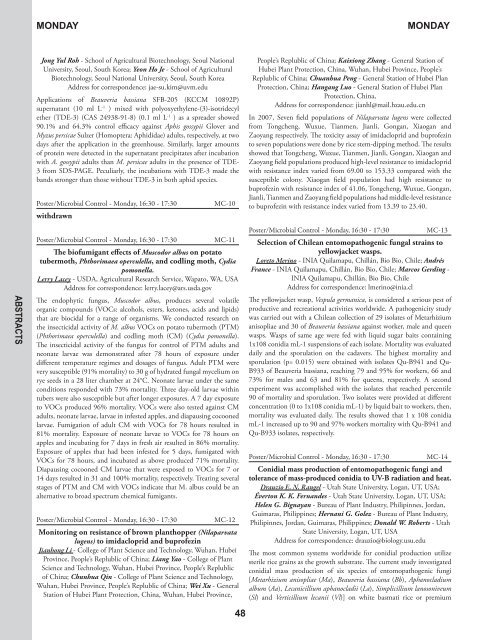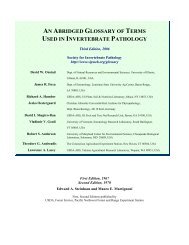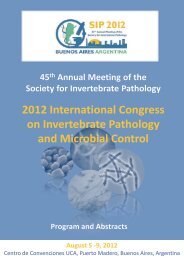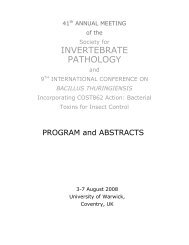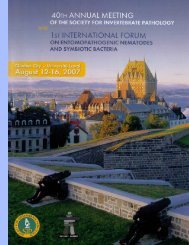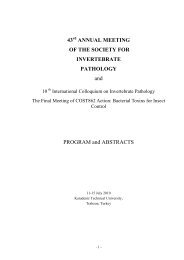ABSTRACTS 2009 - Society for Invertebrate Pathology
ABSTRACTS 2009 - Society for Invertebrate Pathology
ABSTRACTS 2009 - Society for Invertebrate Pathology
You also want an ePaper? Increase the reach of your titles
YUMPU automatically turns print PDFs into web optimized ePapers that Google loves.
<strong>ABSTRACTS</strong><br />
MONDAY MONDAY<br />
Jong Yul Roh - School of Agricultural Biotechnology, Seoul National<br />
University, Seoul, South Korea; Yeon Ho Je - School of Agricultural<br />
Biotechnology, Seoul National University, Seoul, South Korea<br />
Address <strong>for</strong> correspondence: jae-su.kim@uvm.edu<br />
Applications of Beauveria bassiana SFB-205 (KCCM 10892P)<br />
supernatant (10 ml L -1 ) mixed with polyoxyethylene-(3)-isotridecyl<br />
ether (TDE-3) (CAS 24938-91-8) (0.1 ml L -1 ) as a spreader showed<br />
90.1% and 64.3% control efficacy against Aphis gossypii Glover and<br />
Myzus persicae Sulzer (Homoptera: Aphididae) adults, respectively, at two<br />
days after the application in the greenhouse. Similarly, larger amounts<br />
of protein were detected in the supernatant precipitates after incubation<br />
with A. gossypii adults than M. persicae adults in the presence of TDE-<br />
3 from SDS-PAGE. Peculiarly, the incubations with TDE-3 made the<br />
bands stronger than those without TDE-3 in both aphid species.<br />
Poster/Microbial Control - Monday, 16:30 - 17:30 MC-10<br />
withdrawn<br />
Poster/Microbial Control - Monday, 16:30 - 17:30 MC-11<br />
The biofumigant effects of Muscodor albus on potato<br />
tubermoth, Phthorimaea operculella, and codling moth, Cydia<br />
pomonella.<br />
Lerry Lacey - USDA, Agricultural Research Service, Wapato, WA, USA<br />
Address <strong>for</strong> correspondence: lerry.lacey@ars.usda.gov<br />
The endophytic fungus, Muscodor albus, produces several volatile<br />
organic compounds (VOCs: alcohols, esters, ketones, acids and lipids)<br />
that are biocidal <strong>for</strong> a range of organisms. We conducted research on<br />
the insecticidal activity of M. albus VOCs on potato tubermoth (PTM)<br />
(Phthorimaea operculella) and codling moth (CM) (Cydia pomonella).<br />
The insecticidal activity of the fungus <strong>for</strong> control of PTM adults and<br />
neonate larvae was demonstrated after 78 hours of exposure under<br />
different temperature regimes and dosages of fungus. Adult PTM were<br />
very susceptible (91% mortality) to 30 g of hydrated fungal mycelium on<br />
rye seeds in a 28 liter chamber at 24°C. Neonate larvae under the same<br />
conditions responded with 73% mortality. Three day-old larvae within<br />
tubers were also susceptible but after longer exposures. A 7 day exposure<br />
to VOCs produced 96% mortality. VOCs were also tested against CM<br />
adults, neonate larvae, larvae in infested apples, and diapausing cocooned<br />
larvae. Fumigation of adult CM with VOCs <strong>for</strong> 78 hours resulted in<br />
81% mortality. Exposure of neonate larvae to VOCs <strong>for</strong> 78 hours on<br />
apples and incubating <strong>for</strong> 7 days in fresh air resulted in 86% mortality.<br />
Exposure of apples that had been infested <strong>for</strong> 5 days, fumigated with<br />
VOCs <strong>for</strong> 78 hours, and incubated as above produced 71% mortality.<br />
Diapausing cocooned CM larvae that were exposed to VOCs <strong>for</strong> 7 or<br />
14 days resulted in 31 and 100% mortality, respectively. Treating several<br />
stages of PTM and CM with VOCs indicate that M. albus could be an<br />
alternative to broad spectrum chemical fumigants.<br />
Poster/Microbial Control - Monday, 16:30 - 17:30 MC-12<br />
Monitoring on resistance of brown planthopper (Nilaparvata<br />
lugens) to imidacloprid and buprofezin<br />
Jianhong Li - College of Plant Science and Technology, Wuhan, Hubei<br />
Province, People’s Replublic of China; Liang Yao - College of Plant<br />
Science and Technology, Wuhan, Hubei Province, People’s Replublic<br />
of China; Chunhua Qin - College of Plant Science and Technology,<br />
Wuhan, Hubei Province, People’s Replublic of China; Wei Xu - General<br />
Station of Hubei Plant Protection, China, Wuhan, Hubei Province,<br />
48<br />
People’s Replublic of China; Kaixiong Zhang - General Station of<br />
Hubei Plant Protection, China, Wuhan, Hubei Province, People’s<br />
Replublic of China; Chuanhua Peng - General Station of Hubei Plan<br />
Protection, China; Hangang Luo - General Station of Hubei Plan<br />
Protection, China,<br />
Address <strong>for</strong> correspondence: jianhl@mail.hzau.edu.cn<br />
In 2007, Seven field populations of Nilaparvata lugens were collected<br />
from Tongcheng, Wuxue, Tianmen, Jianli, Gongan, Xiaogan and<br />
Zaoyang respectively. The toxicity assay of imidacloprid and buprofezin<br />
to seven populations were done by rice stem-dipping method. The results<br />
showed that Tongcheng, Wuxue, Tianmen, Jianli, Gongan, Xiaogan and<br />
Zaoyang field populations produced high-level resistance to imidacloprid<br />
with resistance index varied from 69.00 to 153.33 compared with the<br />
susceptible colony. Xiaogan field population had high resistance to<br />
buprofezin with resistance index of 41.06, Tongcheng, Wuxue, Gongan,<br />
Jianli, Tianmen and Zaoyang field populations had middle-level resistance<br />
to buprofezin with resistance index varied from 13.39 to 23.40.<br />
Poster/Microbial Control - Monday, 16:30 - 17:30 MC-13<br />
Selection of Chilean entomopathogenic fungal strains to<br />
yellowjacket wasps.<br />
Loreto Merino - INIA Quilamapu, Chillán, Bio Bio, Chile; Andrés<br />
France - INIA Quilamapu, Chillán, Bio Bio, Chile; Marcos Gerding -<br />
INIA Quilamapu, Chillán, Bio Bio, Chile<br />
Address <strong>for</strong> correspondence: lmerino@inia.cl<br />
The yellowjacket wasp, Vespula germanica, is considered a serious pest of<br />
productive and recreational activities worldwide. A pathogenicity study<br />
was carried out with a Chilean collection of 29 isolates of Metarhizium<br />
anisopliae and 30 of Beauveria bassiana against worker, male and queen<br />
wasps. Wasps of same age were fed with liquid sugar baits containing<br />
1x108 conidia mL-1 suspensions of each isolate. Mortality was evaluated<br />
daily and the sporulation on the cadavers. The highest mortality and<br />
sporulation (p= 0.015) were obtained with isolates Qu-B941 and Qu-<br />
B933 of Beauveria bassiana, reaching 79 and 95% <strong>for</strong> workers, 66 and<br />
73% <strong>for</strong> males and 63 and 81% <strong>for</strong> queens, respectively. A second<br />
experiment was accomplished with the isolates that reached percentile<br />
90 of mortality and sporulation. Two isolates were provided at different<br />
concentration (0 to 1x108 conidia mL-1) by liquid bait to workers, then,<br />
mortality was evaluated daily. The results showed that 1 x 108 conidia<br />
mL-1 increased up to 90 and 97% workers mortality with Qu-B941 and<br />
Qu-B933 isolates, respectively.<br />
Poster/Microbial Control - Monday, 16:30 - 17:30 MC-14<br />
Conidial mass production of entomopathogenic fungi and<br />
tolerance of mass-produced conidia to UV-B radiation and heat.<br />
Drauzio E. N. Rangel - Utah State University, Logan, UT, USA;<br />
Éverton K. K. Fernandes - Utah State University, Logan, UT, USA;<br />
Helen G. Bignayan - Bureau of Plant Industry, Philipinnes, Jordan,<br />
Guimaras, Philippines; Hernani G. Golez - Bureau of Plant Industry,<br />
Philipinnes, Jordan, Guimaras, Philippines; Donald W. Roberts - Utah<br />
State University, Logan, UT, USA<br />
Address <strong>for</strong> correspondence: drauzio@biology.usu.edu<br />
The most common systems worldwide <strong>for</strong> conidial production utilize<br />
sterile rice grains as the growth substrate. The current study investigated<br />
conidial mass production of six species of entomopathogenic fungi<br />
[Metarhizium anisopliae (Ma), Beauveria bassiana (Bb), Aphanocladium<br />
album (Aa), Lecanicillium aphanocladii (La), Simplicillium lanosoniveum<br />
(Sl) and Verticillium lecanii (Vl)] on white basmati rice or premium


